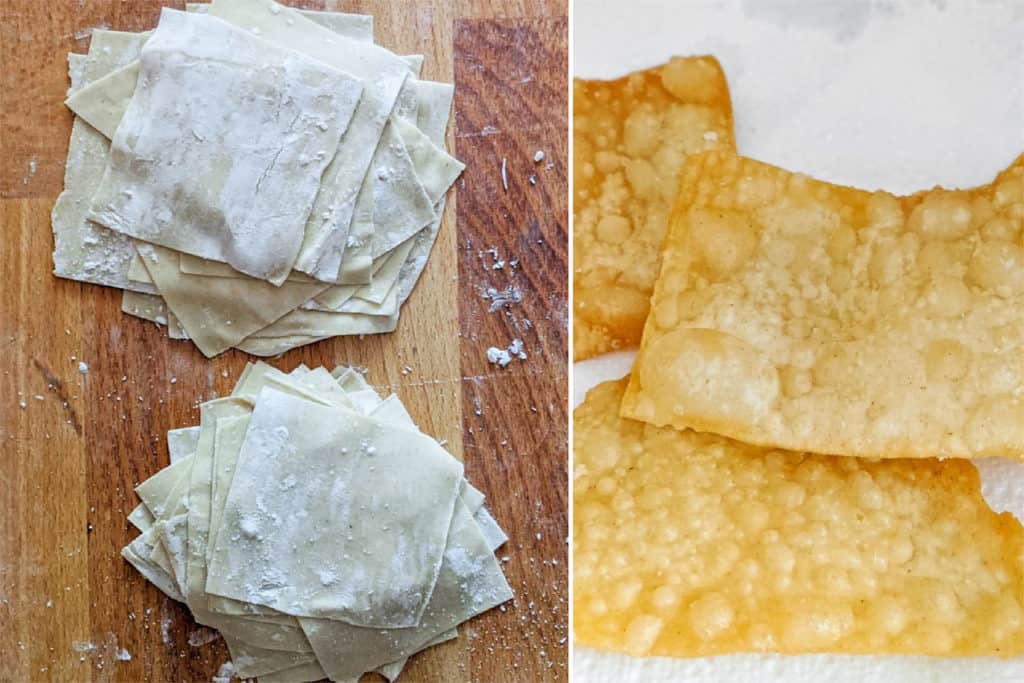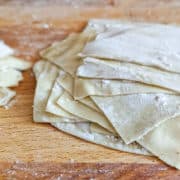I developed this vegan wonton skins recipe for deep frying, specifically as an accompiment for Thai noodle soups. Geow tod, or fried wonton wrappers, are a simple fried trimming that blends beautifully with seasoned stock. This is especially true for yentafo noodles. In Thailand this pink noodle soup generally arrives garnished with a crispy wonton square (or triangles, depending on the cook's preference).
A guilty, if perhaps non traditional, pleasure is to fry more wonton skins than necessary in order to soak up any remaining liquid at the bottom of my bowl of yentafo.

You might notice a seemingly unusual ingredient included in my recipe below. Sodium carbonate is no more than baked baking soda, a method of creating alkaline salts introduced by Harold McGee several years ago. Have a read through my recipe for homemade ramen noodles for more information on alkaline salts and their purpose.
The reason I use sodium carbonate in this recipe is twofold. First it imparts a slight alkaline flavour commonly found in Thai brands I’ve enjoyed over the years. Second, the alkalinity of the dough aids in a longer lasting crispness once fried.
📖 Recipe
Vegan wonton skins (for frying)
Equipment
- pasta machine
Ingredients
- 125 grams all purpose flour
- 20 grams tapioca starch + extra for dusting
- ¼ rounded teaspoon sodium carbonate see notes
- Pinch salt
- 1 ½ teaspoons vegetable oil
- 50-70 millilitres cool water
Instructions
- Mix flour, tapioca starch, salt, and sodium carbonate together in a bowl.
- In another small bowl mix the oil and 50 millilitres of cool water. Pour into the flour mixture. Knead, adding more water, a teaspoon or two at a time, until the dough comes together. Refrigerate the dough for at least an hour.
- Use a pasta machine to make thin 0.8mm to 1mm thickness sheets. Dust liberally with tapioca starch and cut into approximate 8-9cm squares. You can cut these further into triangles, if you wish (some Thai vendors serve them in this shape). Mine are always wonky square-ish shapes. You can use a rolling pin as well, if you want to work for it. Keep in mind the inclusion of sodium carbonate makes for a tougher, less pliable dough.
- Stack the wonton skins you don't intend to use immediately and wrap in cling film or pop in a sealed container. They’ll keep in the fridge for a few days, maybe up to a week. Alternatively you can freeze them.
- Line a large dish, tray, or pan with kitchen roll and set it next to the hob.
- Heat a few inches of oil in a wok to about 190 degrees Celsius (375 Fahrenheit). The wonton skins should take only 15-20 seconds to cook to a deep golden colour. You can test this by tossing a scrap of the pastry in the oil. To cook, add one or 2 of the sheets at a time, turning once or twice, frying until they are bubbly and a light golden colour. Remove with a mesh strainer to the lined tray. Repeat with remaining skins.
- The fried skins will only keep for a couple of days in a sealed container. Consequently I tend to fry as I need them.


Leave a Reply